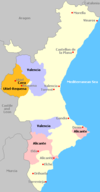Castilla-La Mancha / Levante Flashcards
Castilla-La Mancha

- Castilla-La Mancha
- Large region, SE of Spanish capital Madrid
- Capital city is Toledo; Most populous city is Albacete
- Despite very harsh climate, Castilla-La Mancha produces half of all the wine made in Spain. But, significant proportion goes into the inexpensive mass-produced sector and distillation into brandy.

Castilla-La Mancha
Climate

- btwn 500 - 700 m; Spain at her most extreme
- Winters are long and cold, summer the heat is grueling, little if any rain falls between May and September

Castilla-La Mancha
Varieties

Airen
- Airen is the most planted, but many producers have broadened their portfolios by planting Tempranillo, Cab Sauv, Garnacha, Alicante Bouschet (Garnacha Tintorera), Monastrell, Syrah, Bobal

Castilla-La Mancha
DO zones
8 DOs
- La Mancha DO, *Europe’s largest officially delimited wine zone
- Almansa DO
- Manchuela DO
- Mentrida DO
- Mondejar DO
- Ribera del Jucar DO
- Ucles DO
- Valdepenas DO

La Mancha DO

La Mancha
- Largest delimited wine region not only in Spain, but in the whole of Europe
- More than 500,000 acres (202,350ha) of vineyards
- Finest vineyards are those with high limestone and chalk content in the sub-soil; these semi-porous stones retain precious moisture and help to even out the vines’ water supply

La Mancha DO
White varieties

- Airen: local favorite, accounting for the bulk of production, ideal for distillation into brandy
- Most popular: Chardonnay, Viognier, Macabeo, Torrontes, Verdejo

La Mancha DO
Red varieties

- Tempranillo (Cencibel): by far the most popular red-wine variety, often accompanied by Cabernet Sauvignon and Merlot
- Spanish: Graciano, Bobal, Monastrell
- International: Grenache, Syrah, Petit Verdot

Almansa DO

- Monastrell (Mourvedre): dominant grape variety, regional specialty
- Garnacha Tintorera (Alicante Bouschet): also widely grown, deep-colored, dark-fruit
- Others: Cencibel (Tempranillo), Cabernet Sauvignon, Syrah

Almansa DO white varieties?

Authorized:
- Chardonnay
- Sauvignon Blanc
- Verdejo
- Moscatel de Grano Menudo (Muscat Blanc a Petits Grains)

Manchuela DO

- Red wines dominate
- Native Bobal grape variety goes into unoaked reds and rosés
- Cencibel (Tempranillo) produces some of the best barrel-matured wines
- Monastrell, Garnacha, Cabernet Sauvignon are used in blends
- Syrah has done extremely well here in recent years; future for varietal wines based on Syrah looks promising

Manchuela DO
Styles

- Blanco
- Blanco “Fermentado en Barrica”
- Rosado: min. 85% red varieties
- Tinto
- Tinto “Fermentado en Barrica”
- Vino Espumoso

Garnacha Tintorera aka

Alicante Bouschet
Valencia is ? .
A) a DO
B) an Autonomía
C) the Capital City of said Autonomía
D) All of the above
D) All of the Above

The autonomía of Valencia encompasses what DOs?
- Valencia DO
- Alicante DO
- Utiel-Requena DO

What is the major product of Valencia DO?

-
White wines from Merseguera and other indigenous grapes:
- Macabeo, Malvasia, Moscatel de Alejandria, PX, Planta Fina de Pedralba, Chardonnay
- Recommended Red: Garnacha, Tempranillo, Monastrell, Tintorera, Cab Sauv, Merlot

Valencia DO
Main white grape
Meresguera, fairly neutral
Valencia
- steeped in Catalan and Moorish tradition
- Spain’s 3rd largest city
- better known for oranges and paella (birthplace)
Fondillón
- Oxidative, unfortified dessert wine
- Overripe Monastrell
- Aged in solera for 10 years
- Speciality of Alicante

Alicante
- Grapes
- Styles
Alicante
- Blanco: Merseguera, Airen, Macabeo, Moscatel de Alejandria
- Tinto: Garnacha Tinta, Garnacha Tintorera, Tempranillo, Monastrell
- Blanco, Rosado, Tinto, Doble Pasta, Rancio, Noble, Fondillón, Moscatel de Alicante (VDL/VD)

Alicante Noble
- Exclusively Recommended Varieties
- Aged 30 mos in Wood
- May Not be Fortified

Utiel-Requena DO
Doble Pasta
Traditional style of wine made from the Bobal grape
- Macerated and fermented with double the normal amount of skins and pulp
- Intensely tannic, concentrated, and darkly colored
- Also authorized in Alicante

Utiel-Requena
- Authorized Grapes?
- Styles?
-
W: Planta Nova, Macabeo, Merseguera, Chardonnay, Sauvignon Blanc
- White grapes may account for a max 15% of vineyard acreage
- R: Bobal, Tempranillo, Garnacha, Cab Sauv, Merlot, Syrah
- Blanco, Rosado, Tinto, Superior, Espumoso/Aromaticos, Aguja, VDL, Vendemia Inicial

vendemia inicial

Nouveau
Utiel-Requena Superior
Styles and Varietals
Utiel-Requena Superior
- blanco/rosado/tinto: min 85% preferred varieties
- Blanco: Macabeo, Merseguera, Planta Nova (Tardana), Chardonnay, Sauvignon Blanc, Parrellada, Verdejo, Moscatel de grano menudo
- Tinto: Bobal (rosado), Tempranillo, Garnacha Tinta, Garnacha Tintorera, Cabernet Sauvignon, Merlot, Syrah, Pinot Noir, Petit Verdot, Cabernet Franc
Murcia
3 DOs
- Yecla DO
- Jumilla DO
- Bullas DO


















































